Temperature in the Grow Room For Indoor Hydroponics
Optimal Grow Room Temperature For Indoor Hydroponics
All plants have their optimum temperature, where growth and development are maximised. To maximise results for indoor hydroponics, it’s essential to maintain consistent temperatures in your indoor grow. When growing plants in indoor growing rooms, you must strive to provide the plant with as close to perfect conditions as possible.
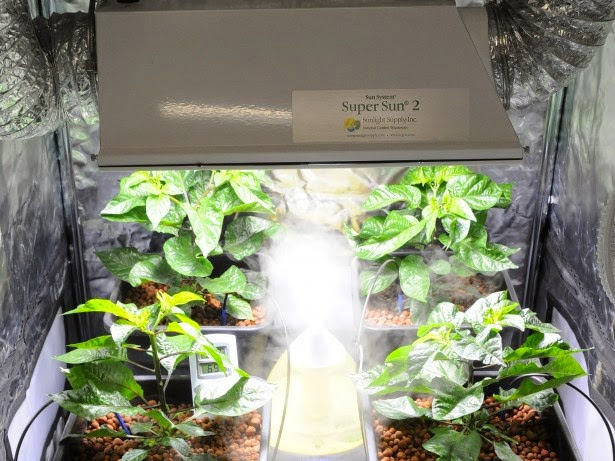
All plants are different, and you should check the specifics for the species that you are growing. The general rule for an indoor hydroponics garden system, is that every plant has a temperature sweet spot (some call this the “goldilocks temperature”).
What Is Indoor Hydroponics?
Indoor hydroponics is the art of growing a variety of plants without soil. Growing plants without soil is usually achieved using a grow tent, extraction fan and ducting, carbon filter and artificial light source, such as an LED grow light.
Indoor Hydroponics – Environmental Control is Everything
For Indoor hydroponics based growing, environmental control is everything for healthy plants. One of the first things you need to learn is how to accurately take the temperature in your grow room. It is even better, if you can automate the control of the temperature.
Digital Thermometers
Thermometers come in many forms and at many prices, for the best accuracy, opt for a digital model. Digital thermometers give accurate results and include helpful features, like memory recall and min- and max-temperature settings. The best digital thermometers have a temperature sensor you hang inside the room and mount control panel outside. This type will allow you to accurately record temperature without disturbing the grow room environment.
Take a Variety of Readings
You’ll also want to measure the temperature in a variety of spots in your grow room. The best places are in the shadier areas and at the canopy level of the plants but not directly under the lights or right by the fans, as this may give a distorted result. There are also inexpensive Wireless Bluetooth models that Log and chart the grow room temperature and humidity over time. This allows greater accuracy than min/max thermometers. They work with precise timings, giving you detailed information and trends when temperature events occur.
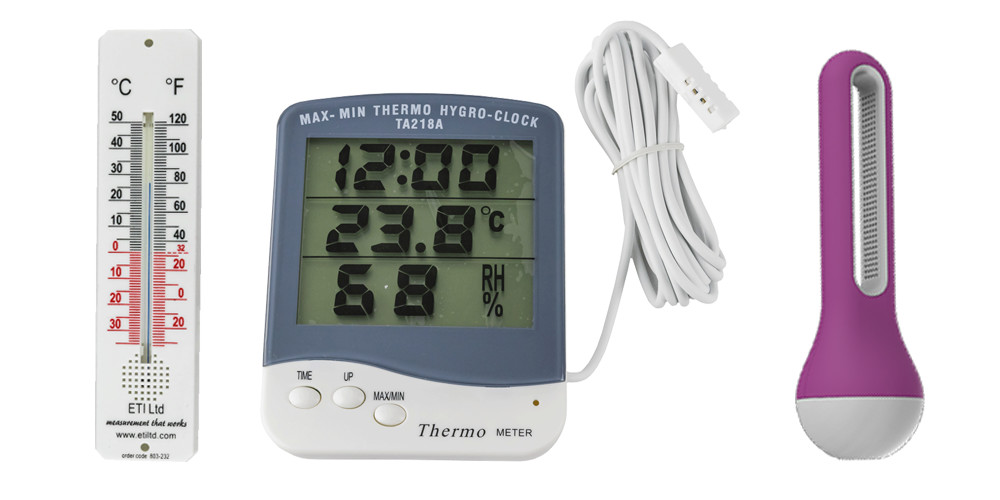
Now we’ll break it down and see what the indoor hydroponics optimum temperatures are throughout your grow. We’ll look at how you can maintain them and how other factors influence things (positively or negatively). There’ll be a few remedies suggested too.
What Effects Do Hot & Cold Temperatures Have On an Indoor Hydroponics Grow Room?
Effects of Cold Temperatures in an Indoor Hydroponics Grow Room
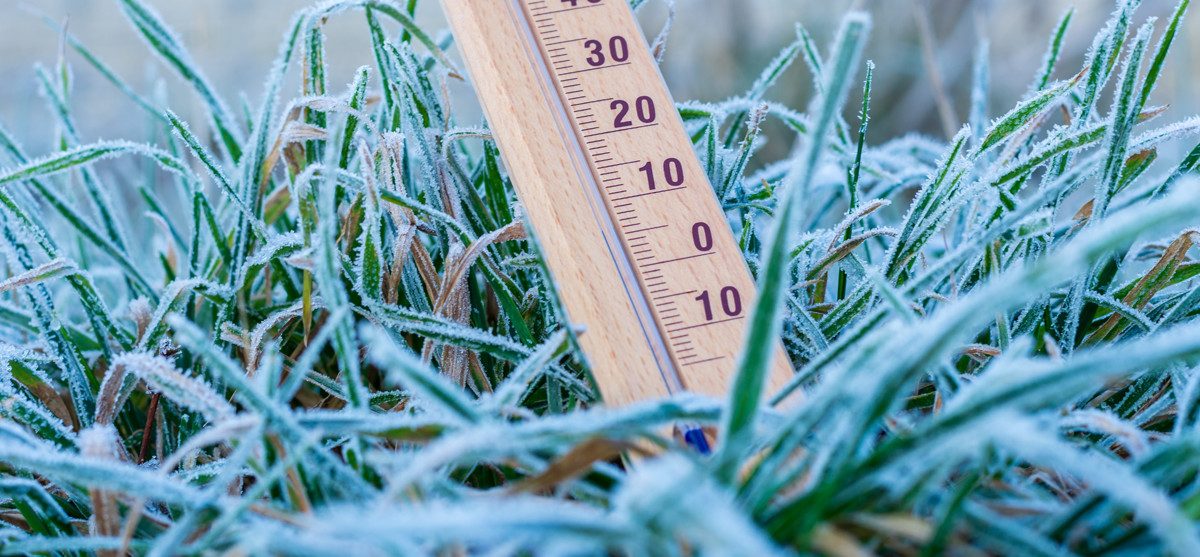
When growing with indoor hydroponics, the environment is a major key to successful plant growth and large yields. One of the major contributing factors to a good hydroponic system’s environment is temperature.
Temperature has a knock on effect on all processes your plant performs. If the temperature in your grow room is too low, it affects photosynthesis by reducing transpiration (evaporation through the leaves). This means that the natural cycle of pulling nutrients up from the roots is decreased. In turn this increases acidity in the medium due to a build up of the nutrients that have not been absorbed.
pH in Hydroponic Gardening
Testing pH levels, and maintaining the correct pH levels is very important for an indoor gardener. pH is a careful consideration, one that you have to get right.
High acidity in the growing medium is a bad thing, as it stops your plant’s roots working efficiently. This will result in the plant taking up fewer nutrients, and water, which will probably slow or completely stunt growth.
You also need to ensure that your hydroponic garden’s water level is correct, well oxygenated, and nutrient rich water. You need to make sure that your plant’s roots can access the water source to access the nutrients.
Effects of Warm Temperatures in an Indoor Hydroponics Grow Room
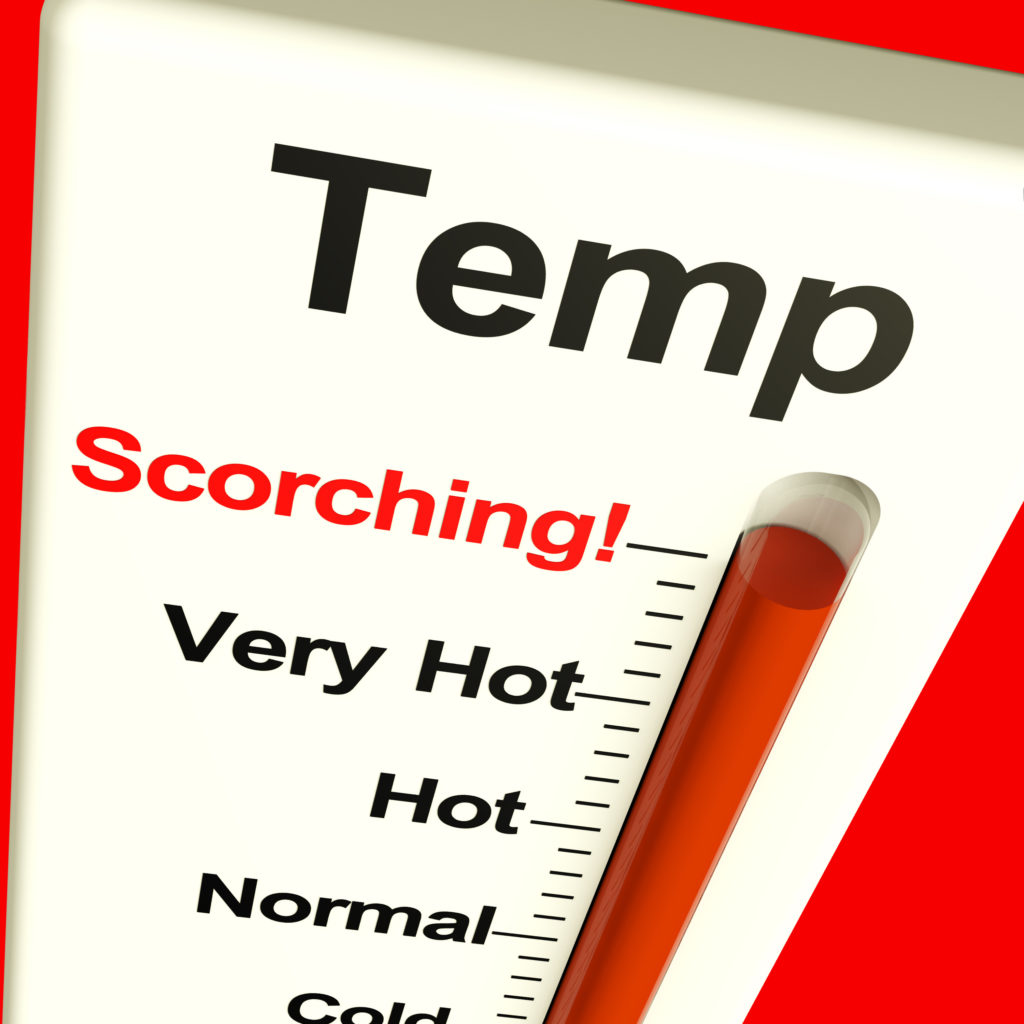
In contrast if the temperature in your indoor hydroponics grow room is too high it can also have an equally adverse effect. High temperatures can have a serious effect on how long it takes your plants to grow, especially during Flower. If temperatures get too high during Flower then it can hit the aroma and taste of your end product as essential oils and terpenes disappear from your plants when it gets too hot.
It’s not just during Flowering that high temperatures can cause issues, there are a multitude of problems that can arise from an overheated grow room. Issues include:
- Nutrient burn from increased water transpiration at high temperatures and;
- Mildew which can form if conditions become too humid.
Under normal conditions, if the temperature at the canopy is too high, your plant will decrease the rate of photosynthesis. This will have a negative effect on all the processes that your plant performs.
Indoor Hydroponics Grow Room Temperature – The balancing act
Getting temperature conditions just right depends on a number of variables:
- The size of your grow room
- Its location
- The airflow in/out and around the grow room
- The number and intensity of the lights
- The power of your fans
- The quality of your extraction equipment
- The plants you’re growing
The list goes on, for instance, a grow tent in your basement will naturally be a lot cooler than one in your loft.
Ideal World Indoor Hydroponics Grow Room Situation
In an ideal world your grow room will have a consistent uniform temperature across its entirety. This can be difficult to achieve due to the heat-producing high intensity lighting. this is more evident in the areas directly around the bulbs. HPS lamps are the most popular lighting choice, and produce large amounts of heat of up to 50C, hence the requirement for adequate fans and extraction.
Running Lights On At Night
If despite your best efforts, you are still experiencing high temperature issues then you could try running your lights through the night when the surrounding temperatures and therefore the air being sucked in to your grow room is much cooler. This is particularly effective if you are growing in a warmer climate or through the summer. If ”lights on” through the night is not an option then you could try and use an air conditioning unit within the area surrounding your growing environment to lower the temperature of any air flow.
Running Fans – Air Movement
You should have at least 2 fans in your grow room, an intake fan to suck fresh cool air in to the environment. This should preferably be from a clean outside source. An outtake fan works to remove warm, stale, Co2 depleted air out of the growing environment.
Fans and lights should be chosen in relation to the size of your growing space, getting this right will give you a good starting point. Having the ability to change the air flow rates of both your intake and out-take fans while they are working in your growing environment is essential to dialing in the optimal conditions.
You should additionally have at least one oscillating, air movement fan that is generally just keeping the air moving around inside the grow room and eliminating hot spots. In tents, clip on fans are perfect as you can attach them directly to the poles, so they don’t take up any floor space.
Optimal Environmental Levels
Temperature & Humidity Through Stages of Growth
Plants perform best at different temperatures and humidity depending on the stage of life they’re in. Young seedlings and clones have a limited capability of up-taking water and nutrients due to a developing root system. As the plants move into the vegetative stage, they can cope with higher transpiration rates, so a slightly lower humidity is advised. As plants go into bloom, they require low humidity to further increase transpiration and reduce the chances of rot.
Propagation (lights on)
For the propagation stage most plants like it warm and wet. Between 23C-27C is the safe zone for temperature and between 70 – 90% humidity.
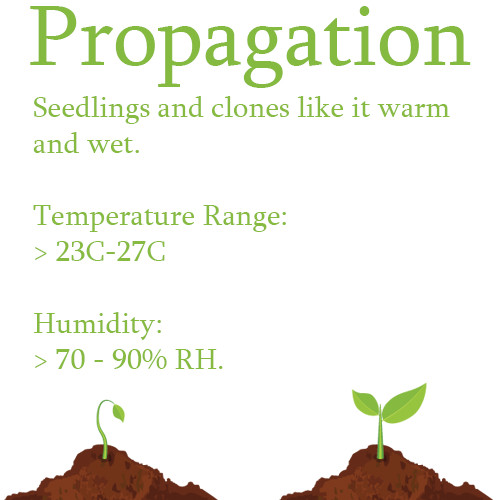
Vegetative (lights on)
For the vegetative stage most plants like it warmer and wet. Between 24C-28C is the safe zone for temperature and between 50 – 70% humidity.
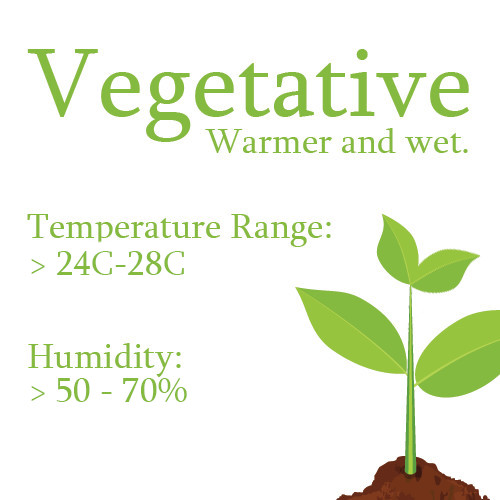
Flower (lights on)
For the flowering stage most plants like it warmer and dry. Between 25C-29C is the safe zone for temperature and between 40 – 50% humidity.
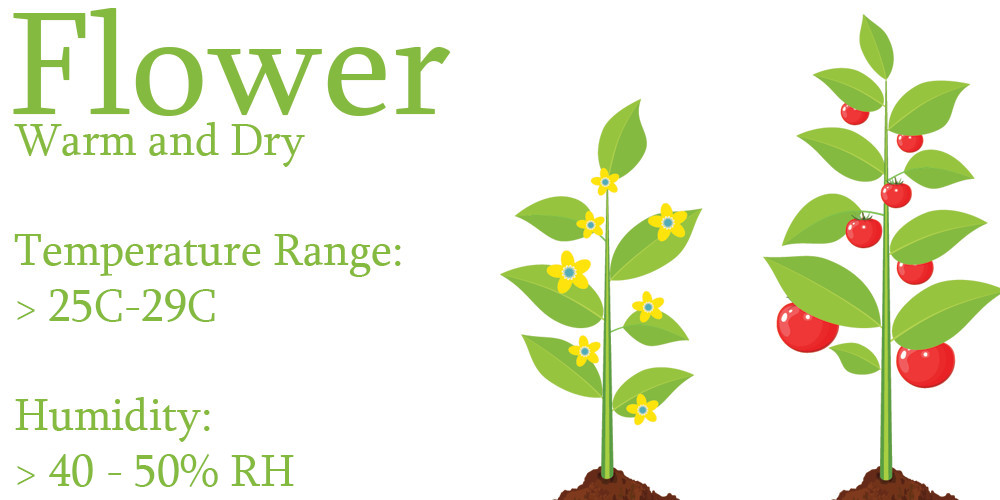
Lights off
The golden rule here is to not let it drop more than 10C below daytime temperatures. If you can keep it to 5C or less, then this is perfect as at this temperature the plant can rest and transpire without any risk of temperature change stress. Plus, in colder temperatures, mould and fungi can develop. The build up of condensation and moisture created by cold conditions directly after warm conditions is the perfect breeding ground for mould growth which could then write off your whole crop and in some cases your equipment too.
Thermostatic Heater
To fight this sudden temperature reduction the use of a heater with a thermostat set to your minimum temp level is ideal. This is a good time to remind you to really consider the location of your grow room before you start your plants off. Ask yourself is it warm/cool enough? Can I easily cool/ heat it up if I need to? Another way to retain heat in colder conditions is to turn your extraction fans down at the same time that your lights go off
Conclusion
It may seem a big mountain to climb with so many variables to monitor and alter. It may take you a few grow cycles to perfect it, but it really is worth putting the hard work in and finding your ideal “set up” and the perfect “sweet spot” for your plants. Maintaining the optimum pH levels and temperatures for your plants is a constantly evolving task. Don’t forget, as well as everything that we have already mentioned, as your plants grow, the environment will change. This happens on a day by day basis as the plants take up more space, drink more feed and photosynthesise.
If you want big yields you have got to master how to get and maintain the optimal temperatures within your grow-room.




